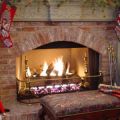The guide to a steel chimney liner installation
Being able to install this type of liner, after reading these instructions, will show that it can be done with common tools that are usually around the house. There’s also no excuse why you should hold off on doing this job because you would reduce the possibility of your chimney having a carbon monoxide leak, a fire or a buildup of creosote. The liners will also increase energy efficiency and make maintaining your fireplace a lot easier than before.
Before you start, make sure you have the appropriate size liner for your home’s chimney and that means having a liner’s diameter equal to the appliance’s exhaust hole. These liners will also need to match the height of the chimney.
Necessary tools
There isn’t any need for special tools for chimney liner installation other than what you should already have in your home – a razor knife, a flat head screwdriver, a caulking gun, a pair of working gloves and safety glasses. You could also choose between a grinder and a hacksaw for cutting off the excess liner.
The chimney lining kit
Even the most basic chimney liner installation kits will come with four major components to get the proper job done – the stainless steel liner, a connector, a plate for the top and a rain cap. Usually the top plate is mesh as the main variable with terra cotta compositions and other materials.
Preparing the metal liner
Usually a plastic wrap covers the chimney relining that can be removed with the razor knife. After that, you have to straighten out the liner from the coiled up position – this has to be done on a grass or soft surface to reduce the risk of puncturing any holes in the liner.
The tee connection
Some lining kits come with a tee connection, which includes a part cut out on the side that is better known as the vertical part of the tee. Then there’s a looping hose clamp that is called the horizontal part. After locating the vertical part and inserting into the liner’s female end, you can tighten the clamp with the screwdriver.
Inserting the liner into the flue
First insert the initial part of the liner while going into the chimney and proceed until reaching the thimble – or the hole on the side of the chimney in the home that allows a stove pipe to connect with the rest of the chimney. You want to twist the flexible liner to help prevent the liner from being caught up on the walls.
Finish the tee connection installation
After finding the tee’s horizontal part, you will want to insert it into the thimble, followed by snaking the vertical part of the tee through the horizontal part’s hose clamp. Then tighten the worm screw inside the tee with the screwdriver until the two parts of the tee are connected – which should be done slowly and securely.
Connect stove pip to the tee
A majority of stove pipes will include three screws for each point of connection. This is where you can use your screwdriver again – or a drill for speed – into the tee’s horizontal part and through the stove’s exhaust collar.
Installing the top plate
Start with using the caulking gun and a tube of silicone to provide a bead along the top of the flue. Then you can thread the liner through the collar of the plate so it is sitting on the top edge of the flue. When locating the locking bolts on the plate’s four sides, you can use the screwdriver to secure it into place.
Removing excess
Cut out the extra lining by using a grinder, but using a hacksaw will work just as well – it just might take a few extra minutes.
Connecting liner to the top plate
Once the liner is flush with the top plate’s collar, you can use the screwdriver to tighten the worm screw so that you can tighten the hose clamp with the lining.
Installing the rain cap
After inserting the top plate’s collar to the rain cap, you will find a hose clamp suspended from the bottom. This will need to be tightened with the screwdriver you have and that will complete the project without having to hire an expensive contractor.
Source: Click Here
Other articles and publications:
Articles and publications of other companies:
- +1 (770) 255-1300
- 1155 McFarland 400 Drive, Alpharetta, GA
- www.chimneysolutions.com/







